Friday, May 28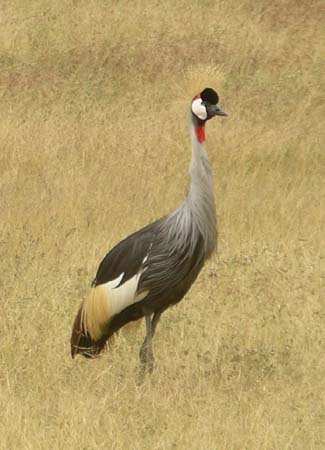
Paula and Steve: Today's final animal count from the
Ngorongoro crater included an amazing 28 different lions (including two that
we saw hunting), 4 of the endangered black rhinoceroses (one being a baby),
more than 25 hippopotami (including the first ones we have seen out of water),
over 12 elephants (with one close encounter), and more gazelles, warthogs,
jackals, hyenas, zebras, buffalo, gazelles, ostriches and wildebeests than
we could ever hope to count! We knew that this area was famous for the variety
of animals that can be seen in a short period of time, but even Nassibu classified
this as one 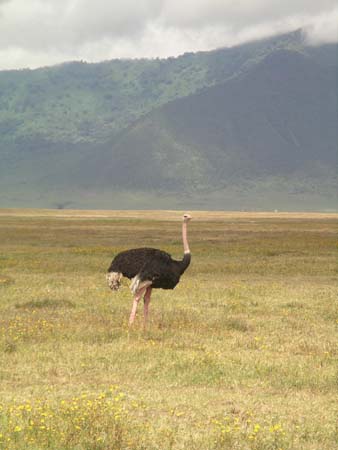 of
those special days where we always seemed to be in the right place.
of
those special days where we always seemed to be in the right place.
This morning brought thick fog to the crater rim, very normal for this area. The weather pattern during the dry season (which we're just now entering) is for foggy and cloudy mornings followed by sunnier and windy afternoons.
As we began our descent to the crater floor, Nassibu told us that the goal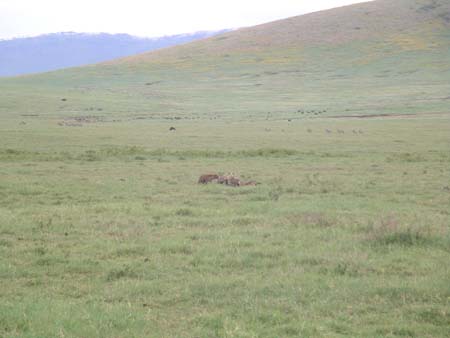 for the early morning was to spot lions that would likely be resting near
the river and waiting for prey coming to drink. Within just minutes of clearing
the thick fog, we sighted a group of jackals and hyenas sharing a large kill
probably taken during the night. From the shape of the animal's horns, it
looked to be a wildebeest. Vultures sat nearby waiting to clean up.
for the early morning was to spot lions that would likely be resting near
the river and waiting for prey coming to drink. Within just minutes of clearing
the thick fog, we sighted a group of jackals and hyenas sharing a large kill
probably taken during the night. From the shape of the animal's horns, it
looked to be a wildebeest. Vultures sat nearby waiting to clean up.
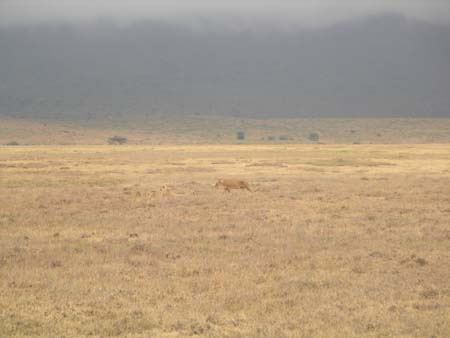 Soon
after, we sighted our first group of lions, three females lounging in the
grass. Nassibu thought we'd see more soon, and as we reached the crater floor
he pointed out two males and a female resting on a grassy hillside. From their
position, Nassibu could tell that the male and female sitting together were
mating. Lions mate for a period of 4-5 days, and often up to 50 times each
day (wow!) The second male was sitting off to the side, and Nassibu explained
that he was waiting to take over in case the first male got tired. Nassibu
suggested that we watch and wait to see what happened, and exactly as he predicted
the male soon got up and mated with his lioness. The entire process probably
took 15 seconds, but both lions appeared exhausted and rolled over on their
backs when it was over. This was certainly a new and interesting happening
for us all to witness, and we were again amazed at Nassibu's ability to recognize
(and even predict) animal behavior so accurately.
Soon
after, we sighted our first group of lions, three females lounging in the
grass. Nassibu thought we'd see more soon, and as we reached the crater floor
he pointed out two males and a female resting on a grassy hillside. From their
position, Nassibu could tell that the male and female sitting together were
mating. Lions mate for a period of 4-5 days, and often up to 50 times each
day (wow!) The second male was sitting off to the side, and Nassibu explained
that he was waiting to take over in case the first male got tired. Nassibu
suggested that we watch and wait to see what happened, and exactly as he predicted
the male soon got up and mated with his lioness. The entire process probably
took 15 seconds, but both lions appeared exhausted and rolled over on their
backs when it was over. This was certainly a new and interesting happening
for us all to witness, and we were again amazed at Nassibu's ability to recognize
(and even predict) animal behavior so accurately. 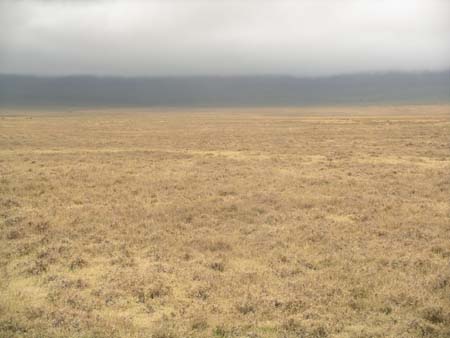
As we continued, we again spotted lions in the distance. We stopped to observe a mother and her group of 3-4 month old cubs resting in some tall grass, and then noticed that there were also several other groups of lions lounging nearby. The more we watched, the more lions we saw (often they lay down behind grass and are not visible until they raise their heads - they're visible in this picture, and this illustrates how hard they can be to see at a distance). Before leaving this spot, we were able to count a total of 17 different lions with our binoculars. These were all part of a large pride that probably consisted of even more lions that we couldn't see (no adult males were visible). We then realized that within the first hour of entering the crater, we had seen 23 lions - almost half of the crater's total estimated population of 50 lions!
Next we headed to an area of the crater where we had observed rhinos yesterday.
On our way, we saw a large number of male elephants. Only bull elephants are
seen in the crater because there are not enough trees to support the families
of females and their offspring that live together. These males are usually
the older bulls who have lost their females to younger and stronger males.
They live out the rest of their lives (usually up to 60 years) in the crater
either in small groups of bachelors or on their own. 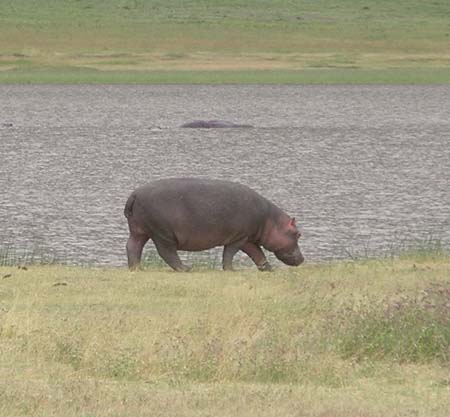
We also saw a large number of hippos lounging out of the water and waited patiently until several stood and walked so that we could admire their large compositions. Until now, we had only been able to observe them in the water but the cooler, cloudy morning weather allowed them to stay on land a bit longer this morning.
At one point, we saw a single elephant walking in the distance. Nassibu suggested
that we go further up the road and wait for him to cross, confident that he
was heading in the direction of a swamp. As we parked the jeep he told us
to be ready for a treat, and jokingly asked David and Katie whether they would
like to be close enough to the huge bull for him to put his trunk in our Land
Rover. We knew that Nassibu was probably somewhat serious. Although none of
this could imagine that this would really happen, we know that Nassibu's intuition
is almost always right so we stayed hopeful. For several minutes, it wasn't
clear at all to us that the elephant was even coming our way. He was taking
his time, meandering through the grass and munching on huge clumps that he
was ripping up with his trunk. We took several pictures him from a distance,
since he was much closer already than most of the elephants we have seen so
far. 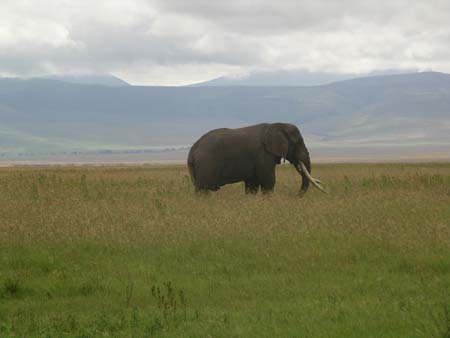
While we waited, several other vehicles came and went, not realizing what was about to happen. Then, after about 15 minutes of waiting, the elephant slowly began making his way toward us. Soon we realized that he was indeed going to cross the road, and Nassibu quickly and carefully moved the Land Rover up to a spot which he thought would give us a perfect view. The elephant kept walking to the road, setting a path directly toward us! Unbelievably, he kept getting closer and closer until we were literally face-to-face with this enormous animal. He was so close that David initially became startled and sat down, fearful primarily of the huge and intimidating tusks that were now only a few small feet away. We could see every wrinkle in the elephant's face, trunk and giant ears, and its breathing was incredibly loud. We watched in awe, being careful not to make any sounds that would startle him. He then crossed the road directly in front of us, stopped to throw dirt over his body to chase away the flies, and then finally lumbered off toward the swamp.
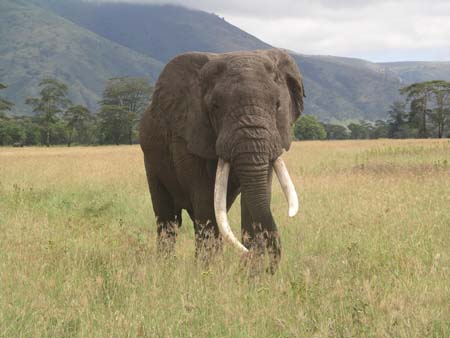 It
was now clear to us that he was looking to join another solitary bull that
was already there - something we never realized but that Nassibu had recognized
all along. Every day we become more and more impressed with Nassibu's intuition
and ability to put us exactly in the right place to witness these wonderful
events.
It
was now clear to us that he was looking to join another solitary bull that
was already there - something we never realized but that Nassibu had recognized
all along. Every day we become more and more impressed with Nassibu's intuition
and ability to put us exactly in the right place to witness these wonderful
events.
We were amazed by our brief encounter and will never forget being eye-to-eye with this magnificent creature. Most elephants end up being viewed at a distance and shy away from people and vehicles. The bulls in particular can become dangerous if threatened and must be treated carefully. This was definitely a once-in-a-lifetime sort of experience for us all.
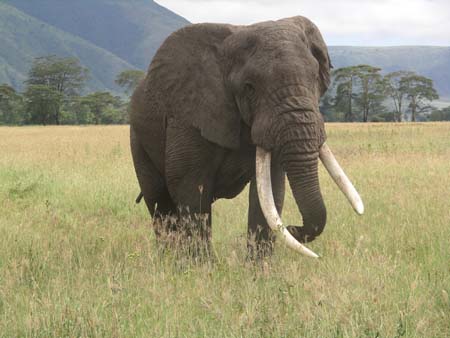
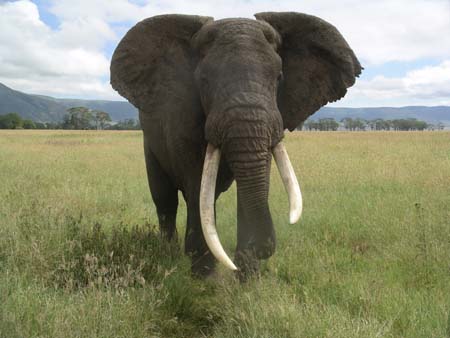
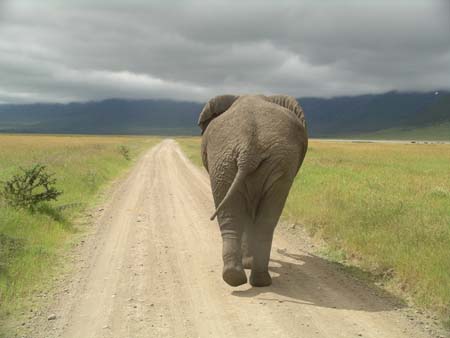
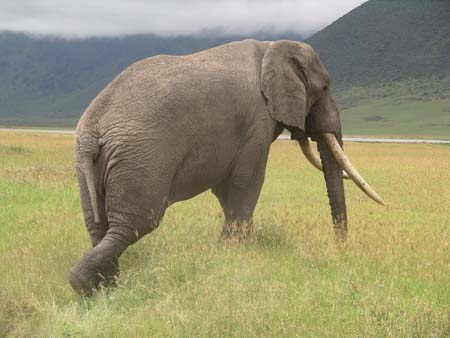
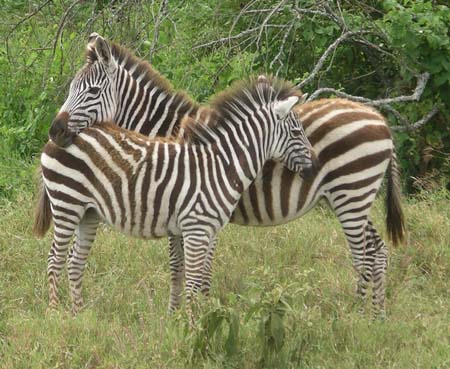
We continued to scan the plains and horizon looking primarily for rhinos and cheetahs, admiring the beauty of the crater and large herds of zebra, buffalo, gazelles, hartebeests and wildebeests. We also saw many warthogs, ostriches and jackals mingling among the larger hoofed animals. Hyenas were easy to spot, with their spotted backs and funny gallops. We caught several napping in the grass as well. It was interesting to stop at a watering hole and we enjoyed watching the zebras and wildebeests drinking and grazing nearby. Several of the female zebras stood in the water encouraging their colts to come in. We observed one of their social behaviors called chin resting - this positioning allows each to rest their chin on the others' back and helps the zebras keep a watch for predators in all directions. We particularly like the zebras, and were able to take several photographs of these beautiful animals at close range today.
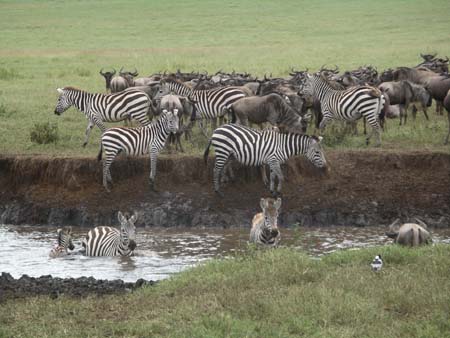
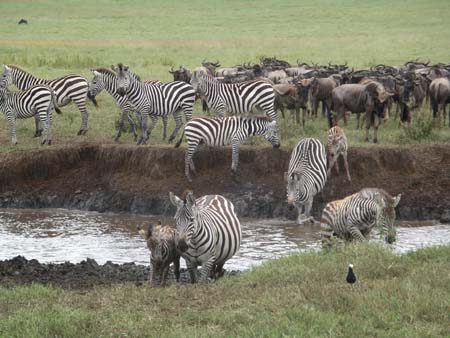
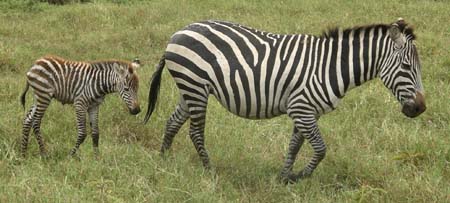
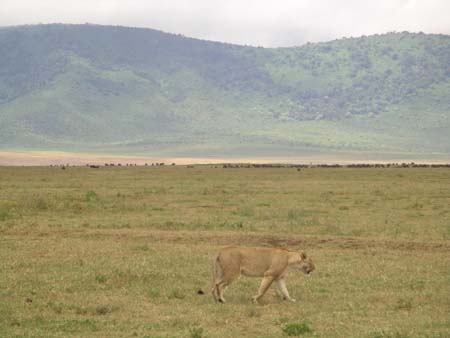
On our way to a spot for lunch, we again spotted a group of lions, this time
much closer to the road. We stopped the jeep and Nassibu quickly sized up
the situation. As we stood and watched, a young juvenile began stalking a
warthog. She looked particularly thin, and was probably very hungry. Nearby,
her mother sat watching attentively and there were also some additional lions
with two cubs sleeping in the distance. As we have learned, lions are not
particularly good hunters and the young lion was not able to catch the warthog
that seemed to know she was stalking and then quickly ran away. The disappointed
cub returned to her mother who 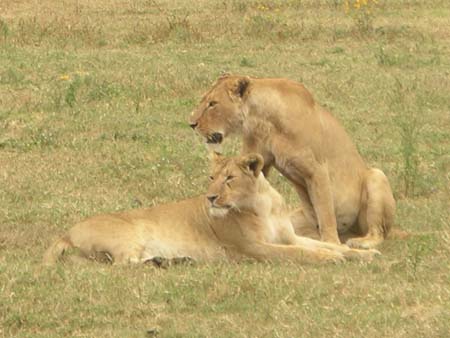 greeted
her affectionately as if to say, "good try, you'll catch one the next
time."
greeted
her affectionately as if to say, "good try, you'll catch one the next
time." 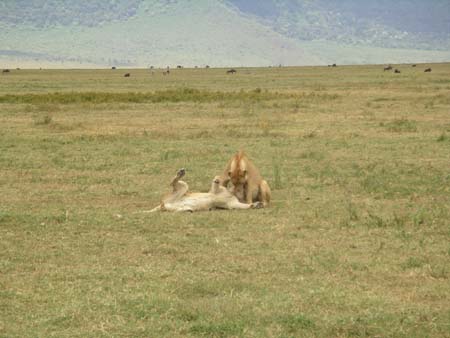
The lions rubbed faces as they greeted each other, and then playfully rolled
over. They then both got up and began walking to join the other lions, and
almost looked to be talking to each other as they went. We guessed that the
mother was telling the juvenile something to the effect of, "Next time,
you should move more quickly when hunting a warthog - they're not that hard
to catch!" It was all very cute to watch. When they reached the other
lions, they all exchanged 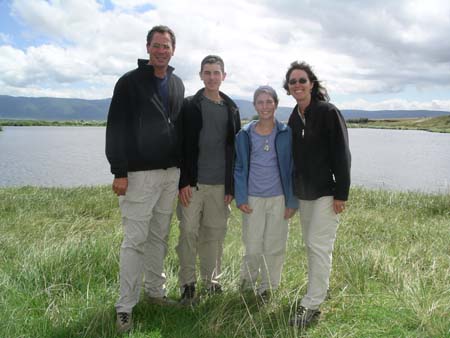 greetings
again. We love watching the behaviors of the lions, and enjoy thinking about
how similar they all are to those of domestic cats at home.
greetings
again. We love watching the behaviors of the lions, and enjoy thinking about
how similar they all are to those of domestic cats at home.
For lunch we headed to Ngoitoktok Springs, one of the few picnic areas in Ngorongoro. There were several other people having lunch here, and the first thing we noticed was that despite the nice weather, everyone was eating inside. We quickly found out why - circling above were several black kites, very aggressive birds of prey. These birds are notorious for swooping down and stealing lunch right out of people's hands, sometimes inflicting bad cuts. We quickly decided that having lunch in our Land Rover wouldn't be so bad…
The springs feed a small pond containing several hippos, and provide a beautiful
setting with good views of the crater. Just as we 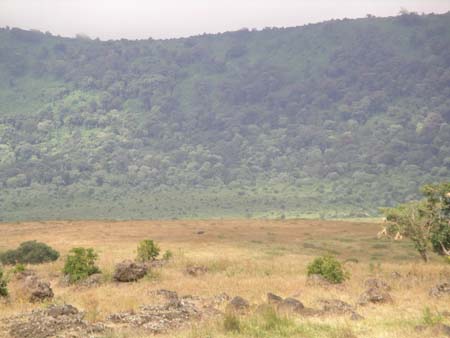 were
finishing our lunches, Nassibu called us excitedly. He had spotted three more
black rhinos on a hillside in the distance - a male, a female and a baby (they're
in the middle of this picture on the right, but too far away to see).. Through
the binoculars we could see them well and enjoyed watching them walk across
the hillside and up and down small gullies. Nassibu hoped that the rhinos
would continue walking and approach the road but the baby quickly tired and
they all settled down for a nap.
were
finishing our lunches, Nassibu called us excitedly. He had spotted three more
black rhinos on a hillside in the distance - a male, a female and a baby (they're
in the middle of this picture on the right, but too far away to see).. Through
the binoculars we could see them well and enjoyed watching them walk across
the hillside and up and down small gullies. Nassibu hoped that the rhinos
would continue walking and approach the road but the baby quickly tired and
they all settled down for a nap.
There are only 16 rhinos in the entire crater, and we realized that we were seeing a very large percentage of the total population here. The rhinos have been hunted nearly to extinction, sought after for their horns that traditionally were made into handles for daggers. Poaching is still a problem, and despite careful tracking of each and every rhino that lives here, we learned that as recently as five years ago a mother was shot here in the crater leaving an orphan that needed to be placed in a wildlife reserve.
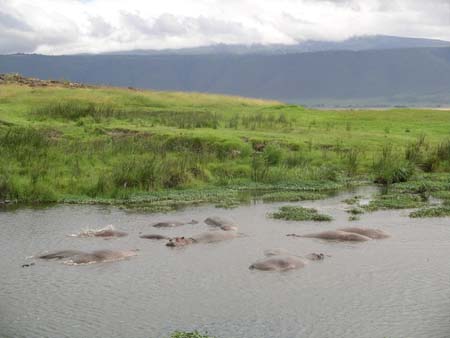 After
lunch we were entertained by a large group of hippos in a small pond called
the "Hippo Pool." These hippos put on quite a show in the water.
Most were cooling themselves by splashing
After
lunch we were entertained by a large group of hippos in a small pond called
the "Hippo Pool." These hippos put on quite a show in the water.
Most were cooling themselves by splashing 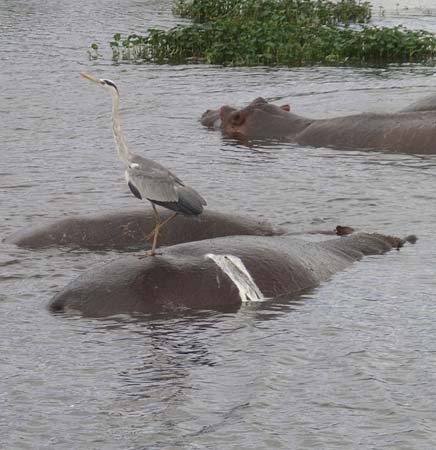 water
on their backs using their surprisingly proficient tails. However, a few of
the hippos preferred to roll over 360 degrees. We loved watching them roll
on their backs in the water exposing their pink stomachs with all four fat
feet in the air. At one point, a grey heron swooped down and landed on one
of the hippos, and we all had a good laugh as he quickly deposited a large
white poop on the helpless hippo's back, and then promptly flew away.
water
on their backs using their surprisingly proficient tails. However, a few of
the hippos preferred to roll over 360 degrees. We loved watching them roll
on their backs in the water exposing their pink stomachs with all four fat
feet in the air. At one point, a grey heron swooped down and landed on one
of the hippos, and we all had a good laugh as he quickly deposited a large
white poop on the helpless hippo's back, and then promptly flew away.
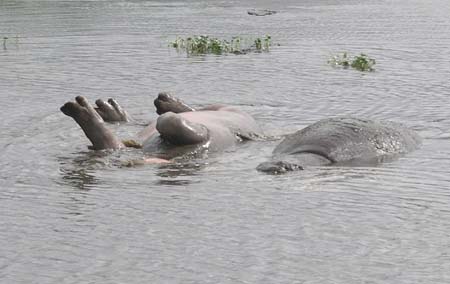
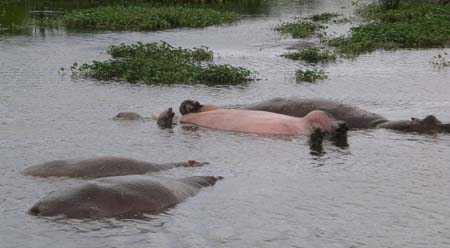
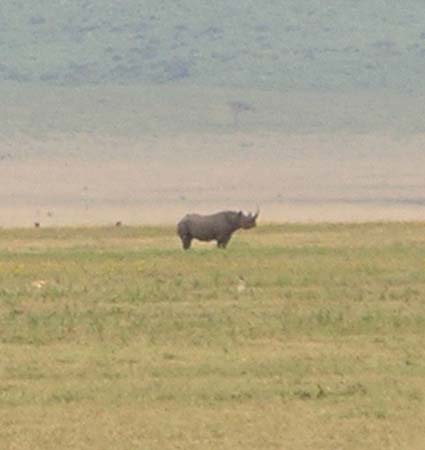
Still hunting for rhino, Nassibu continued to scan the open plains. With
our untrained eyes, we could see nothing but zebras, wildebeests, gazelles
and buffaloes. However, true to form, Nassibu soon spotted a lone black rhino
in the distance. Looking more closely, he told us that the rhino was "Johnny
Walker", Ngorongoro's dominant male. Johnny is easily recognizable because
as an infant its tail was bitten off by a hyena. Since becoming dominant,
Johnny is no longer territorial and instead roams freely across the crater.
Although we still weren't very close, we were able to take a picture where
we at least are able to make out the distinctive shape of this seriously endangered
animal.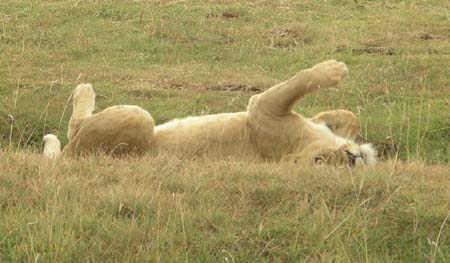
It was time to leave the crater and we were having a hard time accepting that
our day was over. We started our drive back, almost half-expecting that we'd
still have another interesting encounter with an animal. This time Steve was
actually the one to spot a female lion in a small gully just beside the road.
It was his first major sighting of th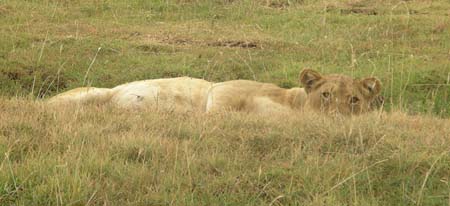 e
trip (Nassibu normally spots everything first, and the things he misses are
normally seen by Paula) and he was quite proud. The lion was actually quite
cute, lying on her back and occasionally peeking up at us. As we sat snapping
photos, Nassibu spotted a
e
trip (Nassibu normally spots everything first, and the things he misses are
normally seen by Paula) and he was quite proud. The lion was actually quite
cute, lying on her back and occasionally peeking up at us. As we sat snapping
photos, Nassibu spotted a 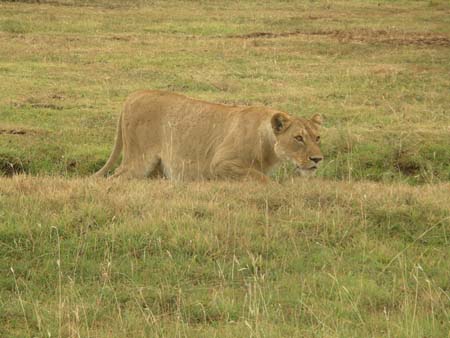 single
wildebeest in the distance approaching a small stream. He then rolled the
Land Rover backwards so the lion could see the wildebeest. Sure enough, as
soon as we backed up the lion came to attention. As we watched, she slowly
began stalking the animal, crossing right in front of us and disappearing
into the brush along the stream. Unfortunately for the lion (but fortunately
for the wildebeest), another jeep approached and despite Nassibu's effort
to get the driver to slow down and turn off his engine, the vehicle frightened
the wildebeest away from the stream. This is one of the unfortunate aspects
of the park - often as visitors we unknowingly interrupt nature.
single
wildebeest in the distance approaching a small stream. He then rolled the
Land Rover backwards so the lion could see the wildebeest. Sure enough, as
soon as we backed up the lion came to attention. As we watched, she slowly
began stalking the animal, crossing right in front of us and disappearing
into the brush along the stream. Unfortunately for the lion (but fortunately
for the wildebeest), another jeep approached and despite Nassibu's effort
to get the driver to slow down and turn off his engine, the vehicle frightened
the wildebeest away from the stream. This is one of the unfortunate aspects
of the park - often as visitors we unknowingly interrupt nature.
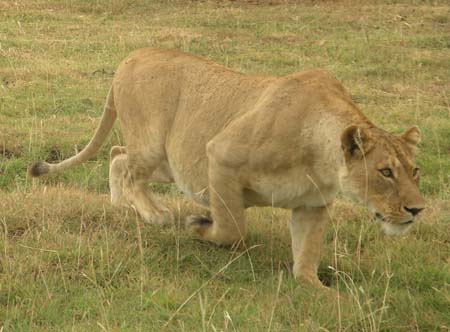
Today was special not only because of our ability to simply view the wildlife, but to begin understanding the behaviors of the animals. Nassibu has been wonderful in explaining why certain animals are acting in specific ways, and also in actually predicting their behaviors.
In a strange way, the Ngorongoro crater feels almost like a huge natural zoo. The walls of the crater, while not technically confining the animals (since they are free to come and go), hold a wonderful variety of wildlife that is amazingly easy to see. Certain animals prefer to spend their time in particular areas of the crater, and it's possible to drive to those spots to see them at close range, somewhat like visiting different sections of a zoo. That's probably where the similarities end, and we all realized at the end of our day that we'll never be able to go to a zoo and feel the same again.
As we approached the lodge, we thanked Nassibu for another fantastic day. Nassibu was happy too - he told us that it had been a great day even by his high standards! Tomorrow, we drive to a Empakaai Crater, which is smaller and more remote caldera here in the Ngorongoro area. We will be hiking down into the Empakaai Crater with Nassibu and an armed park ranger, and then back up again to camp along the rim for the night.
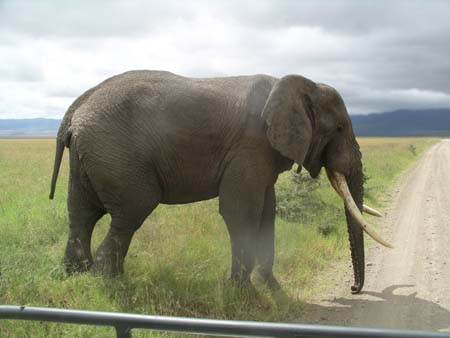
David's Daily Dump: Our Elephant Encounter. Today as we explored Ngorongoro Crater, we encountered a very friendly male elephant. This was no ordinary sighting, but probably THE BEST animal experience we have had and will have on our entire safari…
I was in a state of extreme awe, shock, and terror as the huge African elephant approached us, and stopped within FIVE FEET of our jeep. I could see every single wrinkle and hair on his gargantuan body, which was just about in reaching distance!
As we pulled out of our parking spot at a rest area, Nassibu spotted an elephant
headed toward a small lake for a drink. He said that he would defiantly have
to cross the road to get to the water near the forest, which he guessed was
his destination. As always, we trusted his judgment, and followed him, laughing
about how it would funny if the elephant stuck his trunk in the jeep. Little
did we know that he would be close enough to do it…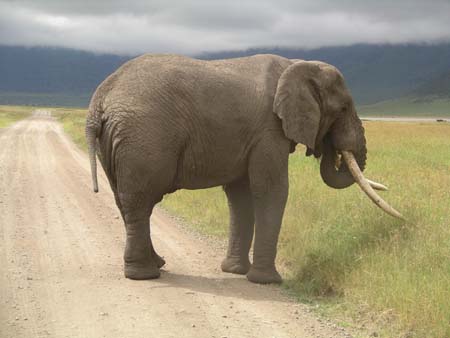
When we finally came in between the lake and the elephant (who was still far away) we decided to settle in and wait to see what would happen. The elephant got closer, and closer, and was headed a little ways in front of us. When he started to get near the road, we drove up closer and beyond him so that the light for taking pictures would be perfect. Before he hit the road, he suddenly changed directions, and headed right toward us! We thought for sure that he would go around us, but he ended up coming alarmingly close to us.
I was amazed at his huge, majestic body, long tusks, and powerful trunk. I was petrified at first, at the thought of him charging right into us or sticking his trunk into the car! But he just stayed were he was and ate the grass by the road. He was absolutely incredible!!! I couldn't possible describe what it was really like. Eventually he moved on across the road, but not before picking up gravel with his trunk and throwing it on top of him to get rid of the flies.
This was an unbelievable experience that I will definitely never forget. Although I tried hard to explain what it was like, it is impossible to capture it in an essay. You'll have to come to Tanzania and experience it for yourself.
Animals seen today:
Lion (28)
Jackal
Hyena
Zebra
Wildebeest
Buffalo
Elephants
Ostrich
Thomson Gazelle
Hartebeest
Hippo
Eland
Rhinoceros (2 males, 1 female, 1 baby)
New Birds:
Black Kite
